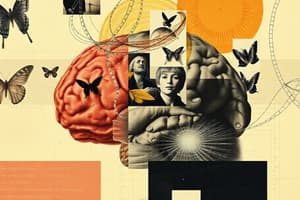Podcast
Questions and Answers
What does neuroplasticity refer to?
What does neuroplasticity refer to?
- The mechanism behind neuron punishment
- The brain's capacity to produce hormones
- The ability of the brain to reorganize itself through new connections between neurons (correct)
- The brain's method for storing memories
Which type of neuroplasticity allows the brain to adapt following an injury?
Which type of neuroplasticity allows the brain to adapt following an injury?
- Injury-induced plasticity (correct)
- Synaptic pruning
- Experience dependent plasticity
- Cognitive plasticity
What is an example of experience dependent plasticity?
What is an example of experience dependent plasticity?
- Forming new connections while learning to play the piano (correct)
- Strengthening long-used neural connections
- Recovering speech after a stroke
- Elimination of unused neural pathways
Which of the following does synaptic pruning lead to?
Which of the following does synaptic pruning lead to?
In which group is neuroplasticity generally considered more flexible?
In which group is neuroplasticity generally considered more flexible?
What does experience dependent plasticity involve?
What does experience dependent plasticity involve?
Which of the following best describes injury-induced plasticity?
Which of the following best describes injury-induced plasticity?
What is the main focus of synaptic pruning?
What is the main focus of synaptic pruning?
Why might neuroplasticity be considered more flexible in children than in adults?
Why might neuroplasticity be considered more flexible in children than in adults?
Which activity could be influenced by experience dependent plasticity?
Which activity could be influenced by experience dependent plasticity?
Flashcards
Neuroplasticity
Neuroplasticity
The brain's ability to change and adapt by forming new connections between neurons.
Experience-Dependent Plasticity
Experience-Dependent Plasticity
The formation of new neural connections when we learn new skills or experience new things.
Injury-Induced Plasticity
Injury-Induced Plasticity
The brain's ability to adapt after injury by allowing other parts of the brain to take over the function of the injured part.
Synaptic Pruning
Synaptic Pruning
Signup and view all the flashcards
Neuroplasticity Over Time
Neuroplasticity Over Time
Signup and view all the flashcards
What is Neuroplasticity?
What is Neuroplasticity?
Signup and view all the flashcards
Types of Neuroplasticity: Experience-Dependent Plasticity
Types of Neuroplasticity: Experience-Dependent Plasticity
Signup and view all the flashcards
Types of Neuroplasticity: Injury-Induced Plasticity
Types of Neuroplasticity: Injury-Induced Plasticity
Signup and view all the flashcards
Types of Neuroplasticity: Synaptic Pruning
Types of Neuroplasticity: Synaptic Pruning
Signup and view all the flashcards
Study Notes
Neuroplasticity Lesson 7
- Definition of Neuroplasticity: The brain's ability to reorganize itself by forming new connections between neurons (brain cells).
Lesson Objectives
- Objective 1: All students can define neuroplasticity.
- Objective 2: Most students understand the different types of neuroplasticity.
- Objective 3: Few students can discuss how neuroplasticity plays a role in cognitive development and rehabilitation.
Types of Neuroplasticity
- Experience-dependent plasticity: The formation of new neural connections when learning new skills or experiencing new things. An example is someone practicing piano, leading to more connections in the motor cortex.
- Injury-induced plasticity: The brain's ability to adapt after injury, where other parts of the brain take over the function of the injured part. Stroke patients might use other brain areas to recover speech and motor skills.
- Synaptic pruning: Neural connections no longer needed die off, while frequently used ones strengthen.
Think-Pair-Share
- Students work in pairs to brainstorm 4 examples of neuroplasticity in daily life. Research is permitted if needed.
Independent Work
- Students consider whether neuroplasticity is more flexible in children or adults and explain their reasoning.
Group Activity
- Students, as a group, participate in brain games.
End of Lesson Reflection
- Students reflect by writing down three things they learned, two interesting things, and one thing they want to know more about.
Studying That Suits You
Use AI to generate personalized quizzes and flashcards to suit your learning preferences.




